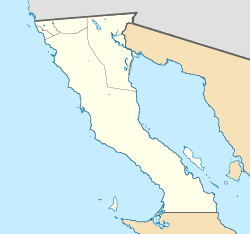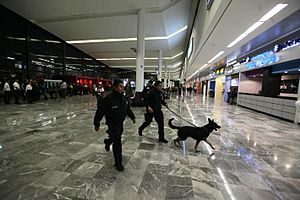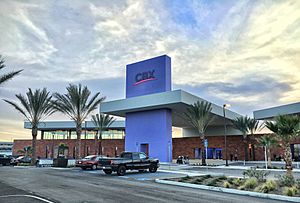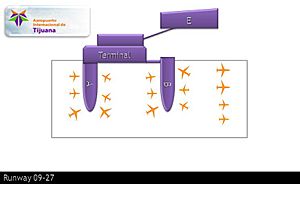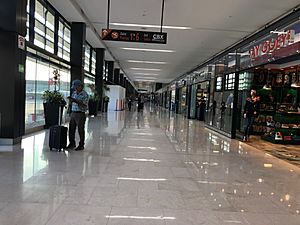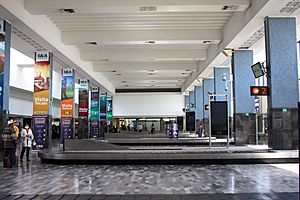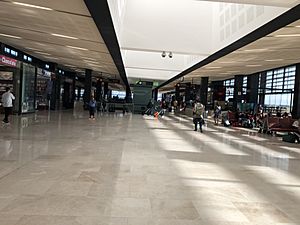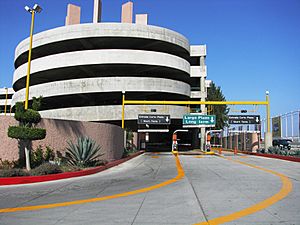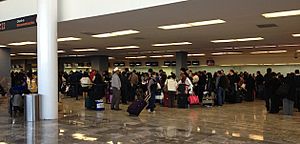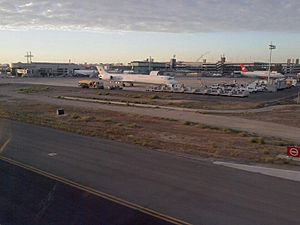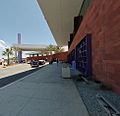Tijuana International Airport facts for kids
Quick facts for kids
General Abelardo L. Rodríguez International Airport
Aeropuerto Internacional General Abelardo L. Rodríguez
|
|||||||||||||||
|---|---|---|---|---|---|---|---|---|---|---|---|---|---|---|---|
 |
|||||||||||||||
| Summary | |||||||||||||||
| Airport type | Public / Military | ||||||||||||||
| Operator | Grupo Aeroportuario del Pacífico | ||||||||||||||
| Serves | Tijuana–San Diego | ||||||||||||||
| Location | Tijuana, Baja California (CBX terminal in Otay Mesa, San Diego, California) |
||||||||||||||
| Hub for | |||||||||||||||
| Elevation AMSL | 489 ft / 149 m | ||||||||||||||
| Coordinates | 32°32′27″N 116°58′12″W / 32.54083°N 116.97000°W | ||||||||||||||
| Website | Aeropuerto Internacional de Tijuana | ||||||||||||||
| Map | |||||||||||||||
| Runway | |||||||||||||||
|
|||||||||||||||
| Statistics (2022) | |||||||||||||||
|
|||||||||||||||
|
Source: Grupo Aeroportuario del Pacífico
|
|||||||||||||||
General Abelardo L. Rodríguez International Airport is often called Tijuana International Airport. It's located in Tijuana, Baja California, Mexico. This airport is Mexico's second-northernmost airport. It sits right next to the US border.
Tijuana Airport is one of the busiest airports in Latin America, ranking 13th. It's also the fourth busiest in Mexico. In 2021, it served over 12 million passengers! The airport can handle up to 10 million passengers and 360 flights every day.
A special bridge called the Cross Border Xpress (CBX) opened in 2015. This bridge lets passengers walk directly from a terminal on the US side to the main airport in Mexico. This makes it super easy for people from the US to fly out of Tijuana.
The main airline that uses Tijuana Airport as a hub is Volaris. A hub is like a main base for an airline. The airport is run by Grupo Aeroportuario del Pacífico, a company that manages 12 airports in Mexico. Tijuana Airport connects to 34 cities within Mexico, making it one of the best-connected airports in the country for domestic flights.
Contents
Airport History: How it Grew
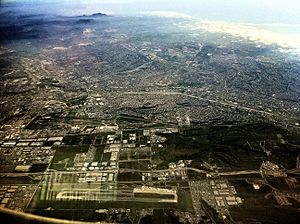
Tijuana Airport first opened on May 1, 1951. It was called "Aeropuerto Federal de Tijuana." It replaced an older airport in the city. The airport was named after Abelardo L. Rodríguez, who was a former Governor of Baja California and later the President of Mexico.
In 1954, the airline Mexicana de Aviacion started direct flights from Tijuana to Mexico City. As more people moved to Tijuana in the 1960s, the need for more flights grew.
Runway and Buildings
The airport's main runway was changed to avoid flying over US airspace. This change made it harder for planes to land in bad weather. However, the new runway and a bigger terminal were finished in 1970. The President of Mexico at the time, Gustavo Diaz Ordaz, opened them.
The original airport terminal became a base for the Mexican Armed Forces. People now call it the aeropuerto viejo, which means old airport.
By 1983, Tijuana was growing very fast. So, the airport needed more space for its terminal and parking. In 1991, the airport expanded its waiting areas and parking lots.
Becoming a Private Airport
In 1995, Mexico started a program to let private companies manage its airports. Tijuana Airport became part of the Pacific Airport Group. This group manages 12 airports in Mexico. In 1999, a group of investors from Spain and Mexico took over the management of these airports.
Modern Expansions
As part of being privately managed, the airport terminal was made bigger and updated in 2002. This doubled its capacity. The paths for planes (taxiways) were also widened for larger aircraft like the Boeing 747.
From 2011 to 2012, the main terminal got big upgrades. These included new customs areas and a new bus terminal.
In 2022, a brand new building called the "Nuevo Edificio Procesador" (New Processing Building) opened. This new building has more check-in counters, security lines, and gates. It also helps with international flights, especially those going to Asia and South America. This new building also makes it easier to get to the United States from international flights using the Cross Border Xpress.
International Flights
For a while, Aeroméxico flew from Tijuana to Tokyo-Narita in Japan. They also had flights to Shanghai, China. However, these international flights stopped in early 2020 because of the COVID-19 pandemic.
Cross Border Xpress (CBX)
The Cross Border Xpress, or CBX, is a unique terminal. It's one of only a few in the world that lets you cross a border directly from an airport. It opened on December 9, 2015.
The CBX has a terminal on the US side of the border. A 390-foot bridge connects this terminal to the Tijuana Airport in Mexico. This means passengers can check in on the US side and then walk across the bridge to catch their flight in Tijuana. It makes it much easier for people in the US to use Tijuana Airport.
The idea for a cross-border terminal was first suggested in 1989. The design for the CBX building was created by a famous Mexican architect named Ricardo Legorreta.
Where is the Airport?
The airport's main runway runs east to west, very close to the US-Mexico border. Planes usually land from the east.
Just north of Tijuana Airport, in San Diego, California, is Brown Field Municipal Airport. Both airports are official entry points for their countries.
Airport Facilities
Tijuana Airport has one main runway and a parallel taxiway. It has a main terminal with 23 gates and a food court. It also has a tall control tower.
On the other side of the main terminal is the Old Airport Terminal. This area is mostly used by the Mexican military. There's also a General Aviation Building (GAB Terminal) for private jets and non-commercial flights.
Main Terminal:
- 23 gates
- 10 jetways (bridges from the terminal to the plane)
- VIP Room Tijuana (a special lounge)
- Food courts
- Customs and Immigration areas
- Taxi and car rental services
- A bus terminal
- Duty-Free shops
- Parking area
New Processing Building:
- 2 gates
- 6 security screening lanes
- 52 check-in counters
- 6 immigration booths
GAB Terminal (for private flights):
- Area for private planes
- VIP room
- Lounges for pilots and passengers
- Two aviation schools are based here.
Old Airport Terminal:
- Used by the Mexican Military and federal police.
- Has areas for planes and helicopters.
Cross Border Xpress ("CBX", Terminal 2):
- VIP room
- U.S. Customs and Border Protection (US border control)
- Sports bar and coffee shop
- Duty-free shop
- Taxi and car rental services
- Parking
Airlines and Destinations
Destinations Map
| Destinations map |
|---|
Passenger Flights
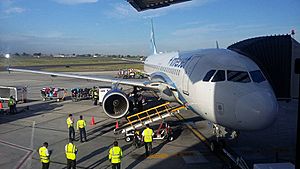
| Airlines | Destinations |
|---|---|
| Aeroméxico | Guadalajara, Mexico City |
| Calafia Airlines | Culiacán, La Paz, Loreto, Los Mochis, Mazatlán, Puerto Peñasco |
| VivaAerobús | Cancún, Culiacán, Guadalajara, León/Del Bajío, Mazatlán, Mexico City, Mexico City–AIFA, Monterrey, Morelia, Oaxaca (begins October 20, 2023), Puerto Vallarta, Reynosa (begins October 20, 2023), San José del Cabo |
| Volaris | Acapulco, Aguascalientes, Cancún, Chihuahua, Ciudad Juárez, Ciudad Obregón, Colima, Culiacán, Durango, Guadalajara, Hermosillo, Huatulco, Ixtapa/Zihuatanejo, La Paz, León/Del Bajío, Loreto, Los Mochis, Mazatlán, Mérida, Mexico City, Mexico City–AIFA, Monterrey, Morelia, Oaxaca, Puebla, Puerto Escondido, Puerto Vallarta, Querétaro, San José del Cabo, San Luis Potosí, Tapachula, Tepic, Toluca/Mexico City, Torreón/Gómez Palacio, Tuxtla Gutiérrez, Uruapan, Veracruz, Villahermosa (begins July 10, 2023), Zacatecas |
Cargo Flights
| Airlines | Destinations |
|---|---|
| Aeronaves TSM | Hermosillo, Querétaro |
| AeroUnion | Mexico City-AIFA |
| Ameriflight | Ontario, Phoenix–Sky Harbor |
| Estafeta | Culiacán, Hermosillo |
| FedEx Express | Memphis, Wichita |
| TUM AeroCarga | Guadalajara, Hermosillo, Toluca/Mexico City |
Airport Statistics: How Many People Fly?
Passenger Numbers
Busiest Routes
| Rank | City | Passengers | Ranking | Airline |
|---|---|---|---|---|
| 1 | 1,191,875 | Aeroméxico, VivaAerobús, Volaris | ||
| 2 | 1,068,321 | Aeroméxico, Magni, VivaAerobús, Volaris | ||
| 3 | 474,739 | VivaAerobús, Volaris | ||
| 4 | 364,503 | VivaAerobús, Volaris | ||
| 5 | 262,365 | VivaAerobús, Volaris | ||
| 6 | 260,227 | VivaAerobús, Volaris | ||
| 7 | 221,255 | Calafia Airlines, VivaAerobús, Volaris | ||
| 8 | 204,546 | VivaAerobús, Volaris | ||
| 9 | 200,702 | VivaAerobús, Volaris | ||
| 10 | 172,825 | VivaAerobús, Volaris | ||
| 11 | 106,098 | Volaris | ||
| 12 | 104,401 | Volaris | ||
| 13 | 98,100 | Volaris | ||
| 14 | 90,289 | Volaris | ||
| 15 | 85,313 | Volaris |
Getting To and From the Airport
Bus Service
You can take a local bus from Downtown Tijuana or Zona Rio to the airport. It costs about $11.00 Mexican Pesos (around US$0.60).
Shuttle Service
Volaris offers a shuttle service from San Diego, California, United States to Tijuana Airport. This helps people from San Diego connect to flights within Mexico. You can catch this shuttle from the Amtrak Station in Downtown San Diego.
Taxi Service
In Mexico, regular city taxis can drop off passengers at the airport, but they cannot pick up passengers from the terminal. The airport has its own special taxi service called SAAT Taxis. These taxis are allowed to pick up passengers from the terminal and take them anywhere in the city. You can find them in the arrivals hall.
Images for kids
See also
 In Spanish: Aeropuerto Internacional de Tijuana para niños
In Spanish: Aeropuerto Internacional de Tijuana para niños
- List of the busiest airports in Mexico
- Transportation in Tijuana
- San Diego International Airport



